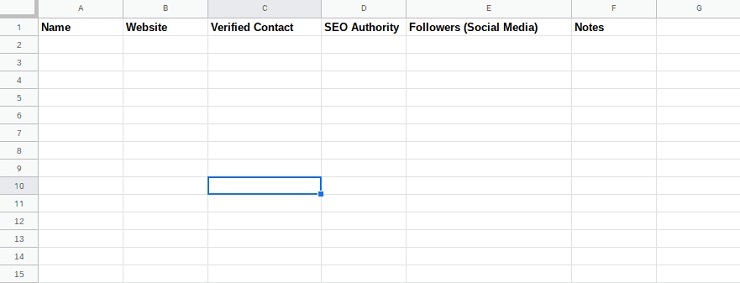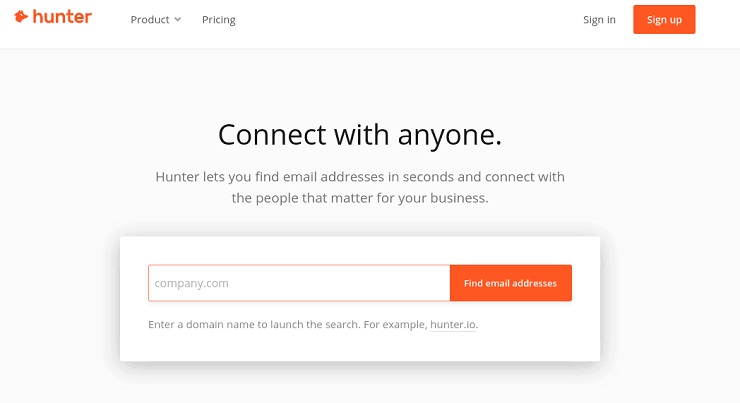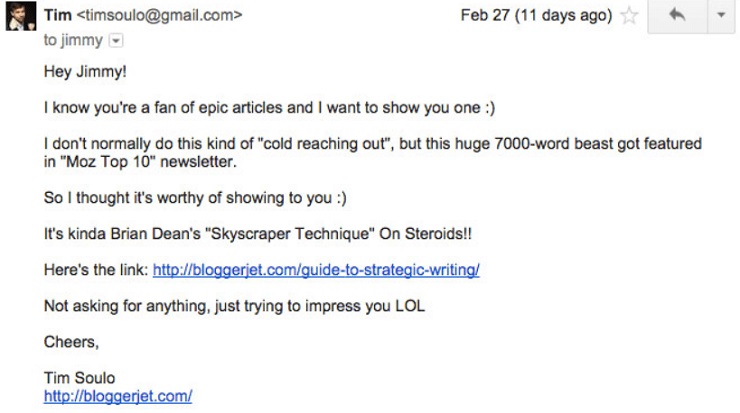Blogger outreach, terrifying as it is for many online marketers, is still one of the rare digital tactics that can pay off several times over. In fact, it’s my go-to tactic whenever I’m trying to improve organic rankings, social media visibility, and website traffic for my clients. And, I’ve figured out a way to do it without feeling like a spammer, or worse, a door-to-door salesman.
Here’s a detailed, but to-the-point, guide that explains what blogger outreach is, what it’s good for, and how to turn it into your secret marketing weapon—all while keeping your costs down and your reputation intact.
EXCLUSIVE FREE TRAINING: Successful Founders Teach You How to Start and Grow an Online Business
What Exactly Is Blogger Outreach?
If you have a company with much of an online presence, you’ve probably been on the receiving end of a campaign. Here’s how you’d recognize it:
(Source: Courtesy of Ahrefs Tim Soulo)
Now, that’s an example of a bad blogger outreach email. It’s all take and no give. Don’t feel bad about deleting something similar to this. As Tim Soulo from Ahrefs writes, this kind of obviously templated outreach is dead, and it’s giving a bad name to anyone out there legitimately trying to build industry relationships.
However, this email does a good job of illustrating what this particular online marketing tactic is all about, which is a lot of connecting with bloggers and emailing them to, essentially, ask them to do you a solid.
Think of blogger outreach as PR on the cheap. Instead of pitching journalists and online publications to write about you and link to your business, you’re reaching out to relevant people in your industry by writing personalized emails, and trying to convince them that what you have to say is important and worthy of sharing.
What’s the Point of Blogger Outreach Campaigns?
When starting out, you don’t have too many opportunities to get in front of large audiences that might be interested in what you’re selling. If you’re taking the easy way out, you’re mostly “paying to play,” with Facebook Ads, Google ads, LinkedIn ads, PR pieces, and more.
This approach is great if you have a decent budget. But, what if you don’t? And what if your goal is not simply to drive traffic and conversions?
If you’re interested in organic rankings, partnerships with others in your niche, and building a brand, blogger outreach is something that you need to seriously consider.
Depending on the ask, we can divide blogger outreach campaigns into several categories.
Link-Building Campaigns
When you’re doing a link-building campaign, you’re reaching out to bloggers to link to your articles and posts in an effort to achieve better organic search rankings. According to Gui Salgado from TopRankings SEO Agency, “blogger outreach is one of the most effective ways to drum up backlinks to a well-written piece of content. Bloggers are very keen to link out, especially to posts that bring value to their readers or feature their content in them.”
Traffic-Driving Social Media Campaigns
This involves getting your content in front of an audience that hasn’t heard about you yet. Established bloggers have social media followings that you can tap into, and drive traffic to your website. The prerequisite here is that you have something of value to share—a valuable how-to guide, an inside scoop, or a data-driven post with original insights.
Partnership Campaigns
You might not be a prolific writer but this doesn’t mean that there isn’t anything that you can bring to the table when reaching out to bloggers. Backlinko’s Brian Dean often teams up with the crew from BuzzSumo to create data-driven posts on how content performs on social media sites. He’s the SEO brain behind the operation but BuzzSumo provides their proprietary data and gets quite a bit of exposure in the process.
Product or Service Promos
While it’s usually difficult to get bloggers to promote your service or product (unless you’re paying them), I’ve seen people try, and succeed. The main thing here is that your offer needs to be so valuable to the blogger’s audience that they’ll look like a hero for promoting it. If you can offer that, go for it.
Awesome Content—The Key to Successful Blogger Outreach
Website content plays a crucial role in blogger outreach. Most of the time, that content is the value that you’re offering to the bloggers, whether as an opportunity to link to it from their site, or to feature it as a guest blogger piece.
Some examples of the content that you can comfortably pitch are:
- Ultimate guides (skyscraper technique) – These are the best and the most comprehensive resources that can be found online regarding a particular topic. To learn more about the skyscraper technique, check out this post by Brian Dean from Backlinko.
- Opposing opinions (substantiated with facts and research) – Good bloggers are not averse to discussing and dissecting their opinions. If you’ve written something that goes against the grain, or explicitly contradicts something that a popular blogger is saying, they will most likely want to see it.
- Pieces created around proprietary data – Do you have access to exclusive data? Use it to write a case study or create an infographic. Bloggers love to share and link to these, especially if they corroborate something that they have been saying all along.
There are definitely more share-worthy types of content, but I’ve found that these work the best, so you probably don’t need to reinvent the wheel on this one.
What’s more important is how you select the bloggers that you’ll be reaching out to. Who are the people and websites whose endorsements and backlinks are of value to you? Do you do it haphazardly, spamming every blogger in your niche with an identical email? Or do you take a more sensible approach, one that doesn’t make people cringe when they see your email in their inbox?
Both approaches have their pros and cons, but only one allows you to move ahead of the pack, and start building a name for yourself in your industry.
Reaching Out to Bloggers—Sniper Approach Trumps Shotgun Approach
There are two ways you can approach blogger outreach:
- The shotgun approach – Basically, you just scrape the email addresses of thousands of blogs in your niche and send out a templated ask, swapping out only people’s names (if that) and hoping for the best.
- The sniper approach – This involves handpicking 50 to 100 bloggers that you can actually research and create personalized emails (that can still be a template but not an obvious one) to send out to them.
I’m a big fan of the sniper approach, which is why I use it in all my blogger outreach campaigns.
Now, those who like to cut corners will say that you can get the same results with both approaches, Mathematically, that may be true:
But, you can get the same result only once!
If you use the shotgun approach, you’re burning valuable bridges.
It’s like Noam Judah from the Digital Rescue Web Design Agency says: “If you use the shotgun approach, people will mark your email as spam, or they’ll remember you by name (especially if they get more than one templated email from you). After that, you’re toast—they won’t ever do anything that you ask them to.”
Could you blame them? Not really.
That’s why I prefer to stick to the sniper approach. Sure, it’s slower, but that means that I can reach out again in a couple of months with a new piece of content without feeling that my email is 100% unwanted or spam.
Step-by-Step Guide to Blogger Outreach Campaigns That Work
Hopefully, I’ve managed to convince you that blogger outreach, when done the right way, is not something that only spammers do. That it’s something you can do to broaden your audience, get your content in front of the right people, climb in organic rankings, and sell whatever it is that you’re selling.
Also, I wasn’t lying when I said that blogger outreach campaigns can be done relatively cheaply—they really can.
But, and I can’t stress this enough, they will require you to invest the one thing that we’re all strapped for: time. Good blogger outreach campaigns are heavily dependant on preparation and organization. I’ll show you the exact process that I use when doing them, but don’t expect fast results. Still, if you put in the work (content) and the time (relationship-building with bloggers), you will likely pick up your first win in a matter of weeks, if not days.
EXCLUSIVE FREE TRAINING: Successful Founders Teach You How to Start and Grow an Online Business
Find Prospects Worth Going After (and Their Actual Email Addresses)
The first step in blogger outreach is finding prospects that are worth your time.
When you think about the influential people in your niche, you’ll quickly notice that they fall into some different categories:
- Leviathans – These are household names and industry leaders. They’ve written top-selling books that are required industry reading. For the marketing niche, think Seth Godin, Gary Vaynerchuk, and others.
- Big Fish – Established industry names. You will easily recognize them because they are the authors of many top-ranking blog posts and articles for your industry keywords. People like Brian Dean (Backlinko) and Tim Soulo (Ahrefs) spring to mind if we’re talking about marketing and SEO.
- Small Fish – Not as big, but still have a presence in the industry. These people are making a name for themselves, much like you are at this point. You will find them promoting themselves heavily in industry Facebook groups, publishing guest posts on each other’s blogs, and participating in events. If you’re working on networking (online and offline), you know quite a few of them already.
- Spawn – These are beginner bloggers who have not committed to audience-building. They’ve published a couple of blog posts but they don’t have an audience yet. You can keep an eye on the most promising ones but you should not consider reaching out to them until they put in the work and start growing.
The first and the last category are of no interest to you. The leviathans are unattainable, and the spawn don’t have big enough audiences to be valuable.
When it comes to your industry’s big and small fish bloggers, there are several ways to find them.
The first, and the most obvious way, is to do a “best blog + niche” Google search. Let’s say you’re looking for paleo diet bloggers. This search term will unearth curated lists of blogs that will look something like this:
There are 46 more bloggers on that list, all with a substantial audience, and all just a well-crafted email away from sharing your content or linking to your latest article.
Here are a few other search strings that will help you find these “best blog” lists:
- blogs to follow
- Best blogs
- Favorite blogs
- Ultimate blogs
Another good way to find outreach prospects is to go to AllTop.com. You’ll find a ton of content on AllTop on every possible subject, from fitness to Formula 1.
The site adds new blog posts daily, so it might be worth it checking it often for those up and coming bloggers who are just starting to make a name for themselves. They’re still small enough to value every industry connection (and to check their email personally) but are working on building their audience, and can potentially hit it big any day now.
There are several more ways to find prospects for your blogger outreach. BuzzSumo is one of them—it lets you find people who are already sharing the type of content you’re creating. Tools like Ahrefs and SEMRush are also worth looking into. They’ll help you uncover the people who are linking to articles on the same topic so you can reach out to them when you create a better resource.
All in all, finding likely prospects will take a day or two of your time. While you’re searching for them, make sure to record the info somewhere. I use a simple Google spreadsheet where I note their name, website, domain authority, social media stats, and anything else that might be of use. I also create a contact column, which brings us to the next point of order: finding the right contact info to send your pitch to.
Find the Right Contact Details
When you’re doing blogger outreach, you want to make sure that your email hits the inbox of the person who is actually behind the blog, the authority who commands industry respect and has a social media following.
What you don’t want is to send your pitch to a generic info@ email address, or the site’s webmaster. Here’s where you can look up the email address that you’re interested in:
- The About section of the blog – Sometimes, bloggers will make your life easier and list their actual email address there.
- Social media profiles of the website and the blogger – The platform that will most likely list the real email address is Twitter (look in the bio section). Alternatively, if you can’t find an email address but the blogger maintains a LinkedIn presence, send your pitch through there.
- Hunter.io tool – Although it’s a paid tool, Hunter.io ends up paying for itself by saving you countless hours you would spend on finding the right email addresses. Do yourself a favor and just spring for it so you can leave this tedious task behind you.
Add the email addresses to your spreadsheet as you find them. Before sending out your email, make sure to verify them. The last thing you want is Gmail flagging your account for sending spam emails. Neverbounce is a good email verification tool but you can find others that are more budget friendly with a simple Google search.
Invest Time in Getting on Your Prospect’s Radar
Look, I know no one has a lot of time to spend buttering up a ton of people they don’t know before they ask them for a small favor that these people might or might not do.
I get that.
But, I also know that most “Big Fish” prospects won’t give you the time of day, even if your name rings a bell. Can you imagine how likely they are to grant you a favor (or even open your email) if they’ve never heard of you? Not likely at all.
With “Small Fish” prospects, you can mostly get away with a “straight to the point” email asking for a share or a backlink, especially if your content is excellent or you mention their name somewhere in there. But, before you can ask for a favor from high-tier bloggers, you need to first get them to notice you.
Here are a few ways you can get on their radar:
- Read and comment on their content – Follow their blog for a month or two and drop a constructive comment on every piece they publish. By the way, “Great stuff” is not a constructive comment.
- Share their content on social media – Obviously, you want to demonstrate to the blogger that you’ve been in their corner for a while. Sharing a couple of their posts on your social media profiles will do just that.
- Subscribe to their email list (and respond to emails) – If the blogger you’re after collects emails, give yours freely. Once they reach out with an update, reply to that email to tell them what you liked about their post or ask a question.
- Offer a helping hand – If you notice something missing from their post, or you find a really ugly spelling mistake, point it out in an email or a comment. You can do the same if you stumble on any broken links on their site. Most bloggers will appreciate your help, and they’ll remember it once you reach out.
Craft the Perfect Pitch
You’ve done the lion’s share of the work up by now. You’ve curated your list of bloggers, found the right contact details, and engaged with your “Big Fish” prospects so that you’re not actually cold-emailing them when the time comes.
And that time is now.
When preparing a pitch, keep your money on the prize and think about the emails that you like to receive and read. They are personalized, relatable, and don’t ask for much (at least, not straight away). Keep all of that in mind when you sit down to write that blogger outreach email.
I’ll share an example of a good blogger outreach email but I want to take a minute to address a couple of key elements that you need to get just right if you want people to even read through your email.
Here’s the anatomy of a good (non-spammy) outreach pitch:
- The subject line is short and informative – And it doesn’t include the words “Amazing Opportunity!!!” Don’t do that. Instead, focus on keeping the subject line close but try to pique people’s curiosity. Things like “New link-building strategy (117% Increase)” might get people to click on it.
- The email knows who it’s talking to – This is where your relationship-building efforts pay off. By now, you’ve probably commented a lot on their blogs, and read enough of their stuff to know how they tick. Open with an inside joke or a reference to something that they personally like (quote their favorite comedian, maybe?), and your email will stand out from 97% of the ones that land in their inbox.
- You’ve explained why you’re reaching out – Instead of saying, “I’m writing because I read what you wrote here and I wanted to say good job,” try saying something meaningful. Share a link of their recent post but ask a question, or share a personal success (or failure) story that resulted from following the advice.
- You’ve finished a call-to-action that invites engagement – Sometimes, asking for a link or a share is the obvious thing to do. However, most times, it’s not even necessary. If your content is great, and you did the work so far on establishing a connection, most bloggers will share your content without you prompting them. I suggest finishing the email with a question:
- What do you think?
- Am I missing something?
- How does this match up against your experience?
Pick any of these, and if you can get the blogger to answer, you’ve struck gold. During the email back and forth, you can casually work in a request for a backlink, something along the lines of: “I’ve noticed this part in your recent post that could benefit from my data/insights. Do you mind creating a paragraph and linking to me?”
As promised, I’ll now share not one, but two examples of a good blogger outreach email. The first one is slightly templated but that’s OK. You can see that the sender took the time to personalize it, and to learn a thing or two about the blogger they were emailing:
The second one is from Ahrefs’ Tim Soulo and breaks most of the rules I’ve outlined above. However, it’s exquisite in its simplicity and expression. You can clearly see that it was written by a human for another human and although it reads like a template, you can feel in your bones that it’s not:
When writing your email pitch, always remember that a human being is on the other side of that. Believe it or not, good jokes work wonders when it comes to making an impression.
Send ONE Follow-Up Email
Here’s the thing—even the bloggers who find your content interesting won’t answer right off the bat. They’ll read the email, think it interesting, and then promptly forget about it as they continue with their day.
That’s why I always send a follow-up email after 48 hours. It’s short, it’s clear, and it promises that they’ll not hear from me on this matter again:
Hey Tom,
I’m writing this quick follow up in case you missed my original email (sent 2 days ago).
If you don’t have time for this now, no worries. I won’t bug you about it again.
In any case, thanks!
That’s all there is to it!
You’ll likely get a few answers back the same day, but even if you don’t, resist the temptation to send another follow up. It will only annoy people.
EXCLUSIVE FREE TRAINING: Successful Founders Teach You How to Start and Grow an Online Business
Ready to Get Cracking with Blogger Outreach?
Blogger outreach campaigns are not nuclear physics. As campaigns go, they are pretty straightforward, even if they do take time. Where most people mess it up is trying to disguise blogger outreach as something else—an amazing opportunity, a once in a lifetime thing—and trick bloggers into doing what they want. This never works.
What I’ve found is that if you approach it as a professional connecting with other professionals, and if you’re honest in your desire to discuss and share ideas, most bloggers will be happy to do it, and help you out in the process. The caveat is that you must have excellent content, so make sure to pick your best work for outreach campaigns!
Did you try blogger outreach yourself and find nothing but disappointment? Comment with your experiences and share a tip or two that you’ve found increases the odds of getting a response!
























